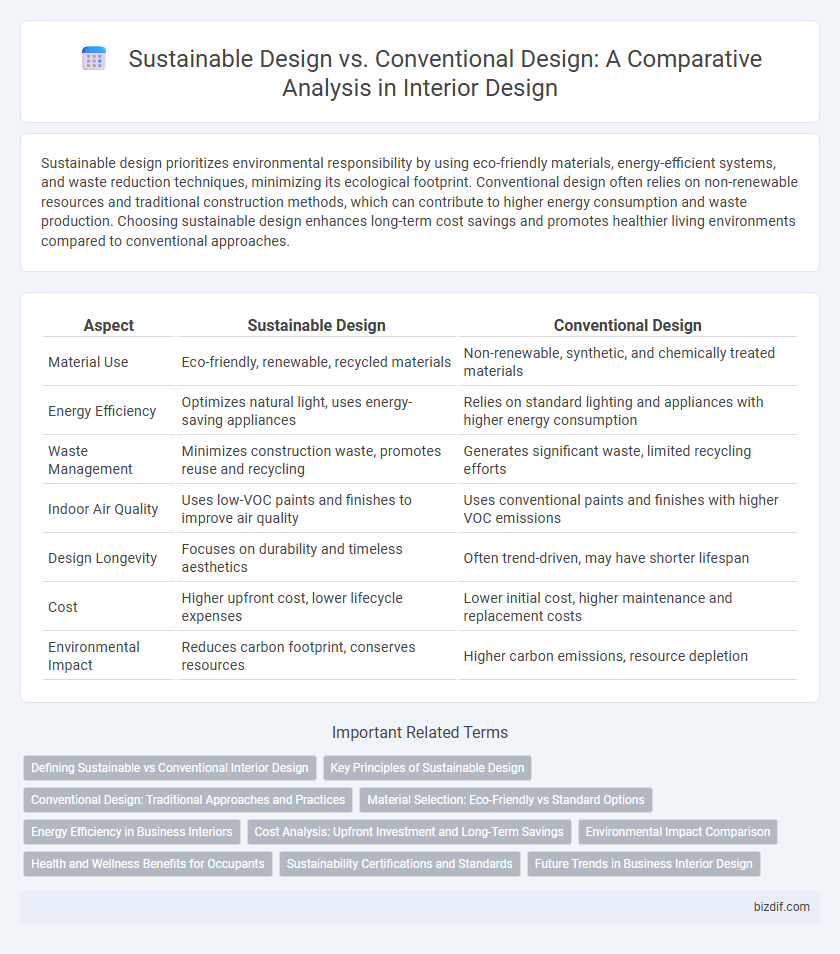Sustainable design prioritizes environmental responsibility by using eco-friendly materials, energy-efficient systems, and waste reduction techniques, minimizing its ecological footprint. Conventional design often relies on non-renewable resources and traditional construction methods, which can contribute to higher energy consumption and waste production. Choosing sustainable design enhances long-term cost savings and promotes healthier living environments compared to conventional approaches.
Table of Comparison
| Aspect | Sustainable Design | Conventional Design |
|---|---|---|
| Material Use | Eco-friendly, renewable, recycled materials | Non-renewable, synthetic, and chemically treated materials |
| Energy Efficiency | Optimizes natural light, uses energy-saving appliances | Relies on standard lighting and appliances with higher energy consumption |
| Waste Management | Minimizes construction waste, promotes reuse and recycling | Generates significant waste, limited recycling efforts |
| Indoor Air Quality | Uses low-VOC paints and finishes to improve air quality | Uses conventional paints and finishes with higher VOC emissions |
| Design Longevity | Focuses on durability and timeless aesthetics | Often trend-driven, may have shorter lifespan |
| Cost | Higher upfront cost, lower lifecycle expenses | Lower initial cost, higher maintenance and replacement costs |
| Environmental Impact | Reduces carbon footprint, conserves resources | Higher carbon emissions, resource depletion |
Defining Sustainable vs Conventional Interior Design
Sustainable interior design prioritizes eco-friendly materials, energy efficiency, and reducing environmental impact by incorporating renewable resources and waste minimization strategies. Conventional interior design often relies on traditional materials and methods without emphasizing environmental sustainability or resource conservation. Defining sustainable versus conventional interior design highlights the contrast between long-term ecological responsibility and standard design practices focused primarily on aesthetics and cost.
Key Principles of Sustainable Design
Sustainable design emphasizes energy efficiency, resource conservation, and the use of non-toxic, renewable materials to minimize environmental impact. It prioritizes indoor air quality, natural lighting, and waste reduction, fostering healthier living spaces and long-term cost savings. Conventional design often overlooks these factors, focusing primarily on aesthetics and short-term function without integrating eco-friendly practices.
Conventional Design: Traditional Approaches and Practices
Conventional design relies heavily on traditional materials such as hardwood, concrete, and synthetic fabrics, often overlooking environmental impact. These methods prioritize aesthetics and functionality without integrating energy-efficient systems or eco-friendly resources. As a result, conventional design frequently leads to higher carbon footprints and increased resource consumption compared to sustainable alternatives.
Material Selection: Eco-Friendly vs Standard Options
Sustainable design prioritizes eco-friendly materials such as reclaimed wood, recycled metal, and low-VOC paints, reducing environmental impact and improving indoor air quality. Conventional design often relies on standard options like plywood, plastics, and formaldehyde-based adhesives, which may contribute to pollution and health issues. Choosing sustainable materials supports resource conservation, enhances durability, and aligns with growing demands for green building certifications like LEED.
Energy Efficiency in Business Interiors
Sustainable design in business interiors prioritizes energy efficiency by integrating advanced insulation, energy-efficient lighting, and smart HVAC systems that reduce energy consumption significantly compared to conventional design. Incorporating renewable energy sources like solar panels and optimizing natural daylight minimizes reliance on non-renewable energy, leading to lower operational costs and a reduced carbon footprint. These energy-saving strategies contribute to enhanced occupant comfort, regulatory compliance, and long-term financial benefits for commercial spaces.
Cost Analysis: Upfront Investment and Long-Term Savings
Sustainable design often requires a higher upfront investment due to the use of eco-friendly materials and energy-efficient technologies, but it offers significant long-term savings through reduced utility bills and lower maintenance costs. Conventional design typically has lower initial costs but may incur higher expenses over time owing to energy inefficiency and frequent repairs. A thorough cost analysis reveals that investing in sustainable design can yield substantial financial benefits and environmental advantages over the building's lifecycle.
Environmental Impact Comparison
Sustainable design drastically reduces environmental impact by utilizing eco-friendly materials, energy-efficient systems, and waste-minimizing construction practices, leading to lower carbon footprints and resource depletion compared to conventional design. Conventional design often relies on non-renewable materials, high energy consumption, and generates significant waste, resulting in greater environmental degradation. Implementing sustainable design principles promotes healthier indoor environments and contributes to global efforts in climate change mitigation.
Health and Wellness Benefits for Occupants
Sustainable design prioritizes non-toxic materials, enhanced natural ventilation, and ample daylight, significantly reducing indoor pollutants and promoting occupant health compared to conventional design. Incorporating biophilic elements and energy-efficient systems in sustainable interiors supports mental well-being and improves air quality, which conventional methods often overlook. Prioritizing these strategies leads to healthier living environments, boosting comfort and productivity for occupants.
Sustainability Certifications and Standards
Sustainable design integrates eco-friendly materials and energy-efficient solutions aligned with certifications such as LEED, WELL, and BREEAM, ensuring reduced environmental impact and improved occupant well-being. Conventional design often lacks adherence to these rigorous sustainability standards, resulting in higher carbon footprints and inefficient resource use. Emphasizing sustainability certifications guarantees accountability and measurable performance in interior design projects focused on environmental responsibility.
Future Trends in Business Interior Design
Sustainable design in business interiors prioritizes energy-efficient materials, low-impact manufacturing, and waste reduction, aligning with growing environmental regulations and corporate social responsibility goals. Future trends highlight the integration of smart technologies and biophilic elements to create adaptive, health-promoting workspaces that reduce carbon footprints and improve employee well-being. Conventional design, often reliant on cost-driven material choices and aesthetic-focused layouts, is increasingly replaced by strategies prioritizing resilience, circular economy principles, and long-term operational savings.
Sustainable Design vs Conventional Design Infographic

 bizdif.com
bizdif.com